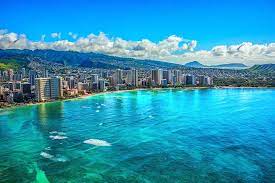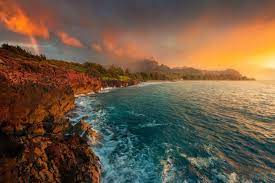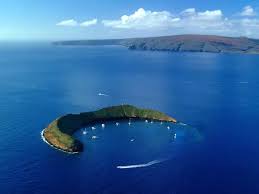
Hawaii Landmarks and Tourist Attractions: Discover the Beauty of the Aloha State
Hawaii, known as the Aloha State, is a tropical paradise that attracts millions of visitors from around the world each year. With its stunning natural landscapes, rich cultural heritage, and warm hospitality, Hawaii offers a myriad of landmarks and tourist attractions that leave visitors in awe. Let’s take a closer look at some of the must-see destinations in this beautiful archipelago.
- Waikiki Beach: Located on the island of Oahu, Waikiki Beach is one of Hawaii’s most famous stretches of sand. Its turquoise waters and golden shores make it an ideal spot for swimming, surfing, or simply lounging under the sun. The beach is lined with luxurious resorts, world-class restaurants, and vibrant nightlife options.
- Pearl Harbor: A visit to Hawaii wouldn’t be complete without paying homage to this historic site on Oahu. Pearl Harbor is home to the USS Arizona Memorial, which commemorates the lives lost during the attack on Pearl Harbor in 1941. Visitors can explore museums and exhibits to gain a deeper understanding of this significant event in American history.
- Haleakala National Park: Situated on Maui, Haleakala National Park offers breathtaking views and unique experiences. The park is home to Haleakala Crater, a dormant volcano known for its stunning sunrise and sunset views. Adventurous visitors can hike through otherworldly landscapes or bike down from the summit for an exhilarating adventure.
- Na Pali Coast: Located on Kauai’s northwestern shore, the Na Pali Coast boasts dramatic cliffs that plunge into crystal-clear waters below. This majestic coastline can be explored by boat or kayak, offering unparalleled views of towering sea cliffs, lush valleys, cascading waterfalls, and secluded beaches accessible only by sea.
- Volcanoes National Park: On Hawaii Island (also known as the Big Island), you’ll find Volcanoes National Park, home to two active volcanoes: Kilauea and Mauna Loa. Visitors can witness the power of nature as they explore lava tubes, hike through volcanic landscapes, and even witness the glowing lava flows at night.
- Road to Hana: This iconic road trip on Maui is a scenic adventure that winds through lush rainforests, past cascading waterfalls, and along rugged coastlines. The journey to Hana is just as captivating as the destination itself, offering stops at beautiful beaches, botanical gardens, and roadside food stands serving local delicacies.
- Waimea Canyon: Known as the “Grand Canyon of the Pacific,” Waimea Canyon on Kauai is a geological marvel that spans over ten miles in length. Its vibrant red and green hues create a breathtaking panorama that can be admired from various lookout points along the canyon rim.
- Molokini Crater: Located off the coast of Maui, Molokini Crater is a submerged volcanic crater renowned for its crystal-clear waters teeming with marine life. Snorkelers and divers flock to this underwater paradise to explore vibrant coral reefs and encounter an array of colorful tropical fish.
These are just a few of the many landmarks and tourist attractions that make Hawaii an unforgettable destination. Whether you’re seeking adventure, relaxation, or cultural immersion, Hawaii offers something for everyone. So pack your bags, embrace the aloha spirit, and get ready to create lifelong memories in this enchanting island paradise.
Explore the Beauty of Hawaii: 9 Must-See Landmarks and Tourist Attractions
- Take a trip to the iconic Diamond Head crater for stunning views of the island.
- Visit Pearl Harbor and pay your respects to those who lost their lives there during World War II.
- Explore the lush rainforests of Hawaii and discover its unique wildlife and plants.
- Enjoy some of Hawaii’s world-famous beaches, such as Waikiki Beach in Oahu or Hapuna Beach on the Big Island.
- Take a boat tour around the Na Pali Coast on Kauai for breathtaking views of its rugged cliffs and lush valleys below.
- Visit Haleakala National Park on Maui to see its volcanic landscape up close, including the dormant volcano itself!
- Hike through Volcanoes National Park on Hawaii’s Big Island to marvel at active lava flows from Kilauea Volcano!
- Experience Hawaiian culture by attending a luau or hula show in one of many resorts across the islands!
- Go snorkeling along any of Hawaii’s beautiful reefs to observe colorful marine life in their natural habitat!
Take a trip to the iconic Diamond Head crater for stunning views of the island.
When it comes to iconic landmarks in Hawaii, Diamond Head crater is undoubtedly a must-visit destination. Located on the island of Oahu, this volcanic cone offers not only a unique hiking experience but also breathtaking panoramic views that will leave you in awe.
Rising 760 feet above sea level, Diamond Head is visible from various parts of Honolulu and Waikiki. Its distinct shape and historical significance make it a prominent feature of the island’s landscape. To truly appreciate its beauty, lace up your hiking shoes and embark on an adventure to the summit.
The hike to Diamond Head is moderate in difficulty and takes you through a series of switchbacks, tunnels, and steep staircases. Along the way, you’ll encounter remnants of military bunkers that date back to World War II, adding an intriguing historical aspect to your journey.
As you ascend towards the top, be prepared for stunning vistas that unfold before your eyes. From the summit, you’ll be rewarded with breathtaking panoramic views of Waikiki Beach, downtown Honolulu, and the vast Pacific Ocean stretching out into the horizon. The sight is nothing short of magical and provides an excellent opportunity for memorable photographs.
It’s advisable to start your hike early in the morning to beat the crowds and avoid peak heat hours. Don’t forget to bring water, sunscreen, and comfortable clothing suitable for hiking. Additionally, keep in mind that there is an entrance fee for accessing Diamond Head State Monument.
Whether you’re an avid hiker or simply looking for a unique vantage point to admire Oahu’s beauty, a trip to Diamond Head crater is well worth it. The combination of natural splendor and historical significance makes this landmark a must-see attraction during your visit to Hawaii. So pack your camera and embark on an unforgettable journey as you soak in stunning views from atop Diamond Head crater.
Visit Pearl Harbor and pay your respects to those who lost their lives there during World War II.
Visit Pearl Harbor: Honoring the Heroes of World War II
When exploring the beautiful islands of Hawaii, a visit to Pearl Harbor is an experience that should not be missed. Steeped in history and significance, this iconic landmark serves as a reminder of the brave souls who lost their lives during the attack on Pearl Harbor on December 7, 1941.
Located on the island of Oahu, Pearl Harbor is home to several memorial sites that pay tribute to those who perished in the attack. The most notable among them is the USS Arizona Memorial, which stands above the sunken battleship and serves as a solemn reminder of the lives lost. As you board a boat to reach the memorial, you can’t help but feel a sense of reverence for those who made the ultimate sacrifice.
The visit begins with a short documentary that provides historical context and recounts the events leading up to that fateful day. As you step onto the memorial itself, silence fills the air as visitors pay their respects and reflect on the magnitude of what occurred. The names engraved on its walls serve as a poignant reminder of each individual who lost their life aboard USS Arizona.
Beyond the USS Arizona Memorial, Pearl Harbor offers other sites worth exploring. The Battleship Missouri Memorial allows visitors to step aboard one of history’s most famous battleships and learn about its role in World War II. The Pacific Aviation Museum showcases an impressive collection of aircraft from different eras, including those used during World War II.
A visit to Pearl Harbor not only educates visitors about this significant event in American history but also provides an opportunity for personal reflection and paying respects to those who sacrificed their lives for their country. It serves as a powerful reminder of how crucial it is to remember and honor our past.
As you leave Pearl Harbor, take a moment to appreciate how far we have come since that tragic day. The resilience and unity displayed by both military personnel and civilians during World War II shaped the course of history. By visiting Pearl Harbor, you contribute to preserving the memory of those who made the ultimate sacrifice and ensure that their stories are never forgotten.
So, when planning your trip to Hawaii, make sure to set aside time to visit Pearl Harbor. It is not only a significant historical site but also a place where you can pay your respects and honor the heroes who lost their lives during World War II.
Explore the lush rainforests of Hawaii and discover its unique wildlife and plants.
Explore the Lush Rainforests of Hawaii: Unveiling Unique Wildlife and Plants
When it comes to natural wonders, Hawaii’s lush rainforests are a treasure trove waiting to be discovered. These vibrant ecosystems are teeming with unique wildlife and plants, offering visitors an immersive experience like no other. So, lace up your hiking boots and get ready to embark on an adventure through the enchanting rainforests of the Aloha State.
Hawaii’s rainforests are abundant with diverse flora and fauna that have evolved in isolation over millions of years. As you traverse the verdant trails, you’ll encounter an incredible array of plant species found nowhere else on Earth. Look out for towering ferns, fragrant flowers such as hibiscus and plumeria, and ancient trees like the majestic ohia lehua.
One of the most iconic rainforest destinations in Hawaii is Hanauma Bay Nature Preserve on Oahu. This marine sanctuary is nestled within a volcanic crater and offers a unique opportunity to explore both land and sea. Take a leisurely hike along the coastal trails, where you’ll be surrounded by lush greenery while enjoying breathtaking views of the turquoise waters below.
For those seeking a more immersive rainforest experience, head to the Big Island’s Akaka Falls State Park. Here, you can wander through dense foliage, following well-maintained paths that lead to stunning waterfalls. The star attraction is Akaka Falls itself, plunging 442 feet into a picturesque gorge surrounded by tropical vegetation.
Another must-visit destination is Kauai’s Na Pali Coast State Wilderness Park. As you hike along this rugged coastline, you’ll find yourself immersed in a world of emerald valleys, cascading waterfalls, and towering cliffs covered in lush greenery. Keep an eye out for endangered bird species like the Hawaiian honeycreeper or even catch sight of a Hawaiian monk seal resting on the shore.
It’s important to note that Hawaii’s rainforests are delicate ecosystems, so it’s crucial to practice responsible tourism. Stay on designated trails, respect wildlife and plants by observing them from a distance, and leave no trace behind.
Exploring the rainforests of Hawaii is an opportunity to connect with nature in its purest form. So, whether you’re an avid hiker or simply seeking tranquility amidst breathtaking scenery, these rainforests will captivate your senses and leave you with memories that will last a lifetime.
Enjoy some of Hawaii’s world-famous beaches, such as Waikiki Beach in Oahu or Hapuna Beach on the Big Island.
Experience the Best of Hawaii’s Beaches: From Waikiki to Hapuna
When it comes to world-famous beaches, Hawaii offers some of the most breathtaking and pristine shores you’ll ever encounter. Whether you’re seeking relaxation, water sports, or simply a stunning backdrop for your vacation photos, Hawaii’s beaches have it all. Two standout destinations that should be on every traveler’s list are Waikiki Beach in Oahu and Hapuna Beach on the Big Island.
Waikiki Beach, located in Honolulu on the island of Oahu, is an iconic stretch of paradise that has become synonymous with Hawaiian vacations. With its soft golden sand and crystal-clear turquoise waters, Waikiki Beach is a true tropical haven. Visitors can take part in a variety of water activities like surfing, paddleboarding, or even trying their hand at traditional Hawaiian outrigger canoeing. The beachfront area is also bustling with vibrant shops, restaurants, and entertainment options to keep you entertained day and night.
On the Big Island of Hawaii lies Hapuna Beach, known for its long stretches of pristine white sand and azure waters. This picture-perfect beach offers ample space for sunbathing, picnicking, or simply strolling along the shoreline while enjoying panoramic views of the Pacific Ocean. Hapuna Beach is also popular among snorkelers and swimmers due to its calm waters and vibrant marine life. It’s an excellent spot for families looking to relax and play in paradise.
Both Waikiki Beach and Hapuna Beach offer more than just sunbathing opportunities; they provide a gateway to explore the unique culture and natural beauty that Hawaii has to offer. Nearby attractions include world-class resorts, shopping districts with local boutiques and international brands, as well as renowned dining establishments serving up delicious Hawaiian cuisine.
No matter which beach you choose to visit in Hawaii, be sure to respect the environment by following local guidelines and practicing responsible tourism. Take care of the pristine surroundings, and remember to leave only footprints behind.
So, whether you find yourself on Oahu’s vibrant Waikiki Beach or the Big Island’s breathtaking Hapuna Beach, prepare to soak up the sun, dive into shimmering waters, and create unforgettable memories in these world-famous Hawaiian destinations.
Take a boat tour around the Na Pali Coast on Kauai for breathtaking views of its rugged cliffs and lush valleys below.
Experience the Majesty of Na Pali Coast: A Boat Tour Adventure in Kauai
If you’re seeking an unforgettable adventure in Hawaii, look no further than the Na Pali Coast on the island of Kauai. This rugged coastline is renowned for its breathtaking beauty, with towering cliffs and lush valleys that will leave you in awe. One of the best ways to truly immerse yourself in this natural wonder is by taking a boat tour along the Na Pali Coast.
As you embark on your boat tour, get ready to be captivated by the dramatic scenery that unfolds before your eyes. The sheer cliffs rise majestically from the crystal-clear waters below, creating a jaw-dropping backdrop that seems straight out of a postcard. The vibrant green valleys nestled between the cliffs add to the picturesque charm of this coastal paradise.
As your boat glides along the coastline, you’ll have ample opportunities to snap incredible photos and soak in the awe-inspiring views. Keep an eye out for cascading waterfalls that tumble down from verdant cliffs into hidden pools below. Dolphins playing in the waves and sea turtles gracefully swimming alongside your vessel are common sights that add to the magic of this experience.
The boat tour also allows you to access secluded beaches and coves that are only reachable by sea. Imagine stepping foot on pristine sands with no other soul in sight, surrounded by nature’s grandeur. It’s an opportunity to escape from the crowds and embrace tranquility in one of Hawaii’s most beautiful settings.
Throughout your journey, knowledgeable guides will share fascinating stories about the history, geology, and cultural significance of Na Pali Coast. They’ll provide insights into its unique ecosystem and point out notable landmarks along the way, enhancing your understanding and appreciation for this natural wonder.
Whether you’re a nature enthusiast, an adventure seeker, or simply someone who appreciates stunning landscapes, a boat tour around Na Pali Coast is a must-do activity in Kauai. It’s an experience that will leave an indelible mark on your memory, as you witness the raw beauty of rugged cliffs, lush valleys, and the vastness of the Pacific Ocean.
So, hop aboard a boat tour and embark on a journey of a lifetime along the Na Pali Coast. Prepare to be mesmerized by its breathtaking views and connect with the untamed spirit of this remarkable destination.
Visit Haleakala National Park on Maui to see its volcanic landscape up close, including the dormant volcano itself!
Visit Haleakala National Park on Maui: Get Up Close to a Volcanic Wonder
If you’re planning a trip to Maui, make sure to include a visit to Haleakala National Park on your itinerary. This stunning national park offers a unique opportunity to witness the volcanic landscape up close, including the awe-inspiring dormant volcano itself.
Haleakala, which means “House of the Sun” in Hawaiian, is a massive shield volcano that forms more than 75% of Maui’s landmass. It last erupted in the late 1700s and has been dormant ever since. The volcano’s summit stands at an impressive elevation of over 10,000 feet (3,000 meters), providing breathtaking views that extend as far as the eye can see.
One of the highlights of visiting Haleakala National Park is witnessing the spectacular sunrise or sunset from its summit. As dawn breaks or dusk settles in, the sky transforms into a canvas of vibrant colors, painting a mesmerizing backdrop against the volcanic terrain. Be sure to dress warmly as temperatures at this elevation can be quite chilly.
For those seeking adventure, there are numerous hiking trails within the park that allow you to explore its unique volcanic landscapes. The most popular trail is the Sliding Sands Trail, which takes you through an otherworldly terrain of cinder cones and lava rock formations. As you hike along this trail, keep an eye out for rare endemic plants and wildlife that have adapted to survive in this harsh environment.
Another way to experience Haleakala’s volcanic wonders is by biking down from its summit. Bike tours offer an exhilarating descent along scenic roads that wind through breathtaking landscapes. Feel the rush as you coast downhill while taking in panoramic views of the island below.
Remember to plan ahead and make reservations if you want to witness Haleakala’s beauty firsthand. Due to its popularity, access to the summit area requires a reservation for sunrise visits, which can be made online.
A visit to Haleakala National Park is an unforgettable experience that allows you to connect with the raw power and beauty of a dormant volcano. So, whether you’re a nature enthusiast, an adventure seeker, or simply someone who appreciates natural wonders, make sure to include Haleakala National Park on your Maui itinerary. Prepare to be captivated by its volcanic landscapes and leave with memories that will last a lifetime.
Hike through Volcanoes National Park on Hawaii’s Big Island to marvel at active lava flows from Kilauea Volcano!
Hike through Volcanoes National Park on Hawaii’s Big Island to Witness the Power of Kilauea Volcano’s Active Lava Flows!
If you’re an adventurous traveler with a love for nature’s raw beauty, hiking through Volcanoes National Park on Hawaii’s Big Island is an experience you won’t want to miss. This stunning national park is home to Kilauea, one of the world’s most active volcanoes, and offers a unique opportunity to witness the mesmerizing sight of active lava flows.
As you embark on your hike, you’ll find yourself surrounded by otherworldly landscapes created by Kilauea’s volcanic activity. The rugged terrain, shaped by centuries of eruptions, paints a picture of both destruction and creation. The contrast between the charred lava fields and the vibrant green flora that emerges from them is awe-inspiring.
The hike takes you along marked trails that lead you closer to the active lava flows. As you approach, the heat intensifies and a faint glow becomes visible in the distance. The anticipation builds as you draw nearer to this incredible natural phenomenon.
Finally, standing at a safe distance, you witness nature’s fiery spectacle firsthand. The molten lava flows down the volcano’s slopes, creating an ethereal glow against the night sky or a stark contrast against the darkened landscape during daylight hours. It’s an experience that leaves visitors humbled by Earth’s power and reminded of its ever-changing nature.
It is important to note that hiking in Volcanoes National Park can be challenging and potentially dangerous due to volcanic gases and unpredictable volcanic activity. Therefore, it is crucial to follow safety guidelines provided by park authorities and be aware of any current alerts or closures before embarking on your adventure.
Hiking through Volcanoes National Park offers a unique opportunity to witness nature in its most primal state. It allows us to appreciate both the destructive force and regenerative power of volcanoes. So, if you’re ready for an unforgettable journey that will leave you in awe of the Earth’s wonders, lace up your hiking boots and venture into the heart of Kilauea Volcano’s active lava flows on Hawaii’s Big Island!
Experience Hawaiian culture by attending a luau or hula show in one of many resorts across the islands!
Experience Hawaiian Culture: Attend a Luau or Hula Show in Paradise
When visiting the beautiful islands of Hawaii, immersing yourself in the local culture is an essential part of the journey. One of the best ways to do this is by attending a luau or hula show, which can be found in many resorts across the islands. These vibrant and captivating performances offer a glimpse into the rich heritage and traditions of Hawaii.
A luau is a traditional Hawaiian feast that brings together music, dance, and delicious food. As you step into the enchanting world of a luau, you’ll be greeted with warm smiles and fragrant flower leis. The sound of rhythmic drumming and ukulele melodies fills the air, setting the stage for an unforgettable evening.
During a luau, you’ll have the opportunity to taste authentic Hawaiian cuisine such as kalua pig (roasted pig), poi (a staple made from taro), lomi salmon (a refreshing seafood dish), and haupia (coconut pudding). These delectable dishes are often accompanied by tropical fruits and refreshing beverages like mai tais or pineapple juice.
As your taste buds savor these culinary delights, your eyes will be treated to mesmerizing hula performances. Hula is an ancient Hawaiian dance form that tells stories through graceful movements and gestures. Dancers adorned in colorful costumes sway their hips to the rhythm of traditional chants and songs, transporting you to a world steeped in history and legend.
Attending a hula show offers a deeper appreciation for Hawaiian culture as it showcases different styles of hula, from ancient chants to modern interpretations. You’ll learn about significant aspects of Hawaiian life such as love, nature, mythology, and even historical events.
Many resorts throughout Hawaii offer luau experiences that cater to both locals and tourists alike. Whether you’re on Oahu’s bustling Waikiki Beach or enjoying the tranquility of Maui, you’ll find a luau or hula show that suits your taste and schedule. These cultural events provide an opportunity to connect with the local community, learn about their customs, and celebrate the spirit of aloha.
So, if you’re seeking an authentic Hawaiian experience, make sure to include attending a luau or hula show on your itinerary. It’s a chance to embrace the vibrant culture of Hawaii, indulge in delicious cuisine, and witness the beauty of hula dancing. Get ready to be captivated by the sights, sounds, and flavors that make Hawaii such a magical destination.
Go snorkeling along any of Hawaii’s beautiful reefs to observe colorful marine life in their natural habitat!
Experience the Vibrant Underwater World of Hawaii: Snorkeling Adventures Await!
When it comes to exploring the wonders of Hawaii, don’t forget to dip beneath the surface and discover the breathtaking marine life that thrives in its crystal-clear waters. One of the best ways to immerse yourself in this vibrant underwater world is through snorkeling along Hawaii’s beautiful reefs.
Hawaii is renowned for its stunning coral reefs, which are home to an incredible array of colorful fish, sea turtles, and other fascinating marine creatures. Whether you’re a seasoned snorkeler or a beginner, there are plenty of spots across the islands that offer unforgettable snorkeling experiences.
One popular destination for snorkeling is Molokini Crater off the coast of Maui. This submerged volcanic crater boasts pristine waters and an abundance of marine life. Dive into its depths and witness schools of tropical fish darting among vibrant coral formations. Keep your eyes peeled for graceful sea turtles gliding by, as they are a common sight in these waters.
Another fantastic spot for snorkeling is Hanauma Bay Nature Preserve on Oahu. This protected marine sanctuary is teeming with a kaleidoscope of fish species, including parrotfish, butterflyfish, and tangs. With its calm waters and shallow reefs, Hanauma Bay is perfect for beginners or those looking for a relaxed snorkeling experience.
For those seeking a more adventurous snorkeling excursion, head to Kealakekua Bay on Hawaii Island. This historic bay not only offers an opportunity to observe diverse marine life but also features an underwater monument known as Captain Cook’s Monument. Snorkel alongside colorful coral gardens while learning about the area’s rich history.
Before embarking on your snorkeling adventure, remember to respect Hawaii’s delicate ecosystem by practicing responsible snorkeling techniques. Avoid touching or stepping on coral reefs as they are fragile living organisms that take years to grow. Apply reef-safe sunscreen to protect both your skin and the marine environment.
Snorkeling in Hawaii is an unforgettable experience that allows you to witness the beauty of marine life in its natural habitat. So grab your snorkel, mask, and fins, and get ready to explore the underwater wonders that await you in Hawaii’s pristine reefs. Dive in, be amazed, and create memories that will last a lifetime!







